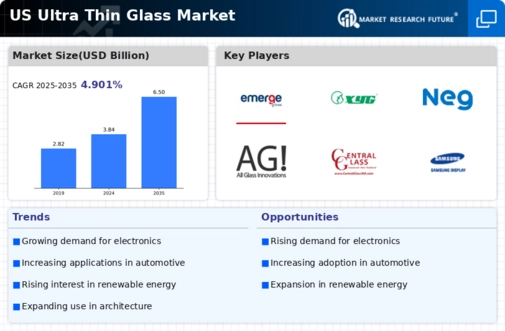US Ultra-Thin Glass Market Summary
As per Market Research Future analysis, the US ultra thin-glass market size was estimated at 3800.0 USD Million in 2024. The US ultra thin-glass market is projected to grow from 4149.6 USD Million in 2025 to 10000.0 USD Million by 2035, exhibiting a compound annual growth rate (CAGR) of 9% during the forecast period 2025 - 2035
Key Market Trends & Highlights
The US ultra thin-glass market is poised for substantial growth driven by technological advancements and diverse applications.
- Technological advancements are enhancing the performance and versatility of ultra thin-glass products.
- The consumer electronics sector represents the largest segment, while renewable energy applications are emerging as the fastest-growing segment.
- Sustainability initiatives are increasingly influencing market dynamics, with manufacturers focusing on eco-friendly production methods.
- Rising demand for lightweight materials and increased investment in research and development are key drivers propelling market expansion.
Market Size & Forecast
| 2024 Market Size | 3800.0 (USD Million) |
| 2035 Market Size | 10000.0 (USD Million) |
| CAGR (2025 - 2035) | 9.2% |
Major Players
Corning Inc (US), Schott AG (DE), AGC Inc (JP), Nippon Electric Glass Co Ltd (JP), Saint-Gobain (FR), Asahi Glass Co Ltd (JP), Xinyi Glass Holdings Ltd (HK), Guardian Glass (US)
















